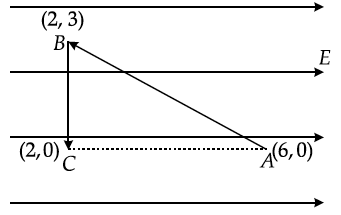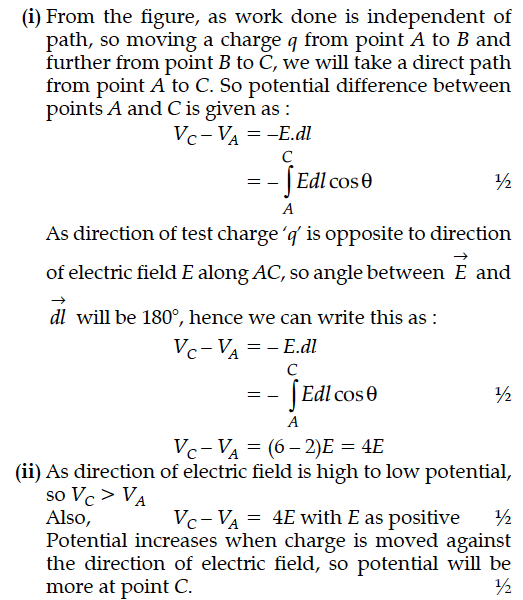A test charge q is moved without acceleration from A to C along the path from A to B and then from B to C in electric field E as shown in the figure.

(i) Calculate the potential difference between A and C.
(ii) At which point (of the two) is the electric potential more and why ?

(i) Calculate the potential difference between A and C.
(ii) At which point (of the two) is the electric potential more and why ?

A point charge +Q is placed at point O as shown in the figure. Is the potential difference – positive, negative or zero ?
Four point charges Q, q, Q and q are placed at the corners of a square of side ‘a’ as shown in the figure.
(i) Derive the expression for the electric potential due to an electric dipole at a point on its axial line.
(ii) Depict the equipotential surface due to electric dipole.
15 joule of work has to be done against an existing electric field to take charge of 0.01C from A to B . Then potential difference ( \(V_B\) –\(V_A\))is
1. 1500 volts
2. -1500 V
3 .0.15 Volt
4 .15 Volt
A charge ‘q’ is moved from a point A above a dipole of dipole moment ‘p’ to a point B below the dipole in equatorial plane without acceleration. Find the work done in the process.
Derive an expression for potential due to a dipole for distances large compared to the size of the dipole. How is the potential due to dipole different from that due to single charge ?
Three capacitors 3 μF, 6 μF and 6 μF are connected in series to a source of 120 volt. The potential difference across the 3 μF capacitor will be
(a) 40 volt
(b) 30 volt
(c) 40 volt
(d) 60 volt
Draw a plot showing the variation of resistivity of a (i) conductor and (ii) semiconductor, with the increase in temperature. How does one explain this behaviour in terms of number density of charge carriers and the relaxation time ?
Calculate the current drawn from the battery by the network of resistors shown in the figure.
Two point charges q1 and q2 are located at points (a, 0, 0) and (0, b, 0) respectively. Find the electric field due to both these charges at the point (0, 0, c).
A cell of emf E and internal resistance r is connected to two external resistances R₁ and R₂ and a perfect ammeter. The current in the circuit is measured in four different situations :
(i) without any external resistance in the circuit
(ii) with resistance R1 only
(iii) with R1 and R2 in series combination
(iv) with R1 and R2 in parallel combination.
The currents measured in the four cases are 0.42 A, 1.05 A, 1.4 A and 4.2 A, but not necessarily in that order. Identify the currents corresponding to the four cases mentioned above.
The figure shows a plot of terminal voltage ‘V’ versus the current ‘i’ of a given cell. Calculate from the graph
(i) emf of the cell and (ii) internal resistance of the cell.
Two electric bulbs P and Q have their resistances in the ratio of 1 : 2. They are connected in series across a battery. Find the ratio of the power dissipation in these bulbs.
Calculate the amount of work done to dissociate a system of three charges 1 mC, 1 mC and – 4 mC placed on the vertices of an equilateral triangle of side 10 cm.
